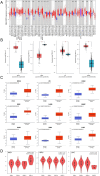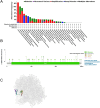EBNA1BP2 identified as potential prognostic biomarker for multiple tumor types in pan-cancer analysis
- PMID: 39394548
- PMCID: PMC11469992
- DOI: 10.1007/s12672-024-01326-0
EBNA1BP2 identified as potential prognostic biomarker for multiple tumor types in pan-cancer analysis
Abstract
Background: Epstein-Barr virus (EBV) infection has been closely linked to the development of various types of cancer. EB nuclear antigen 1 binding protein 2 (EBNA1BP2) is a crucial molecule for stable isolation of EBV in latent infection. However, the role of EBNA1BP2 in multiple tumor types is remains unclear. In this study, we comprehensively analyzed the functional characteristics of EBNA1BP2 and investigate its potential as a prognostic biomarker in pan-cancer.
Methods: We utilized data from TCGA (The Cancer Genome Atlas) and GEO (Gene Expression Omnibus) databases and employed various bioinformatics analysis tools, including TIMER2.0, HPA, GEPIA2.0, PrognoScan, cBioPortal, CancerSEA, and BioGRID to explore the expression pattern, prognostic value, immune infiltration, and methylation level of EBNA1BP2 in pan-cancer. Additionally, we conducted enrichment analysis of genes associated with EBNA1BP2 to identify potential biological functions and pathways.
Results: Our analysis revealed that EBNA1BP2 expression was significantly higher in tumor tissues compared to tumor-adjacent tissues. We observed that lower expression of EBNA1BP2 in adrenocortical carcinoma (ACC), brain lower grade glioma (LGG), sarcoma (SARC), and uterine carcinosarcoma (UCS) was significantly associated with improved overall survival (OS) and disease-free survival (DFS). Furthermore, the promoter methylation level of EBNA1BP2 was downregulated in the majority of cancer types. At the single-cell level, EBNA1BP2 was found to be positively correlated with cell cycle and DNA repair processes, while negatively correlated with hypoxia. Additionally, EBNA1BP2 was associated with the infiltration of immune cells such as B cells, cancer-associated fibroblast cells, and CD8+ T cells. Gene enrichment analysis indicated that EBNA1BP2 was mainly involved in nucleoplasm and RNA binding pathways.
Conclusion: Our findings suggest that EBNA1BP2 may serve as a potential prognostic biomarker for survival in pan-cancer. Further experimental studies are needed to validate these findings and explore the underlying mechanisms by which EBNA1BP2 contributes to tumorigenesis.
Keywords: Biomarker; EBNA1BP2; Pan-cancer; Prognosis.
© 2024. The Author(s).
Conflict of interest statement
The authors declare no competing interests.
Figures








References
-
- Hanahan D. Hallmarks of cancer: new dimensions. Cancer Discov. 2022;12(1):31–46. 10.1158/2159-8290.CD-21-1059. - PubMed
-
- Siegel RL, Miller KD, Wagle NS, Jemal A. Cancer statistics, 2023. CA Cancer J Clin. 2023;73(1):17–48. - PubMed
-
- Farrell PJ. Epstein-Barr virus and cancer. Annu Rev Pathol. 2019;14:29–53. 10.1146/annurev-pathmechdis-012418-013023. - PubMed
-
- Huber MD, Dworet JH, Shire K, Frappier L, McAlear MA. The budding yeast homolog of the human EBNA1-binding protein 2 (Ebp2p) is an essential nucleolar protein required for pre-rRNA processing. J Biol Chem. 2000;275(37):28764–73. 10.1074/jbc.M000594200. - PubMed
Grants and funding
- 82302640/National Natural Science Foundation of China
- 2023A04J1129/Guangzhou Municipal Science and Technology Project
- 202002030404/Guangzhou Municipal Science and Technology Project
- 2021BSGZ018/Doctoral Workstation Foundation of Guangdong Second Provincial General Hospital
- B2023038/Guangdong Medical Research Foundation
LinkOut - more resources
Full Text Sources
Research Materials
